#cadaver monument
Explore tagged Tumblr posts
Text
youtube
"Dethroned Emperor" (Celtic Frost cover) by Deadbird - From "Cadaver Monuments" split (2023)
0 notes
Text

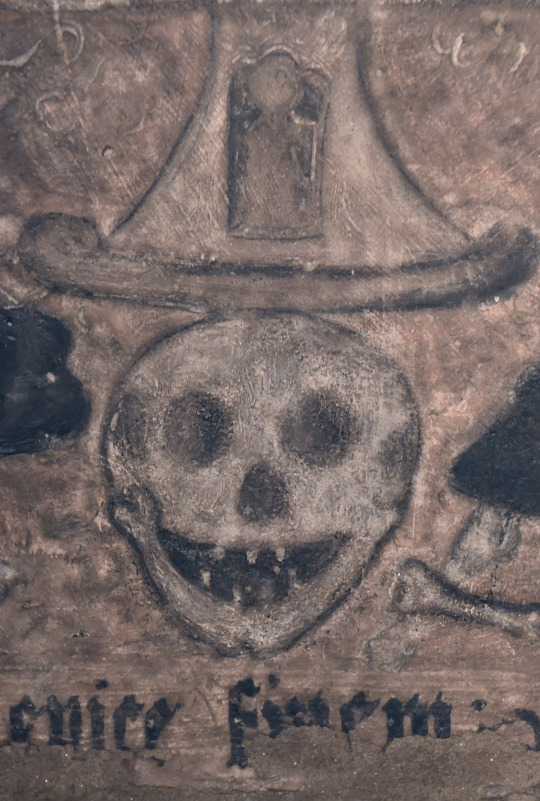
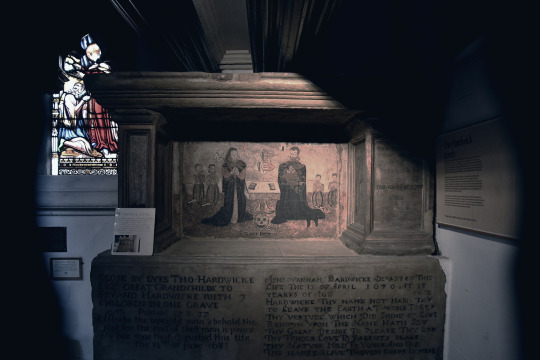
The Hardwick Monument- complete with grinning skull and cadaver with shovel- Leeds Minster, UK
#leeds#leeds minster#goth#gothic#creepy#horror#folk horror#haunted#spooky#goth aesthetic#memento mori#skull#skull art#elizabethan#decay#england#skulls#skull and crossbones
56 notes
·
View notes
Photo

Detail of Alice Chaucher’s tomb, St Mary's Church, Ewelme, 1470s
Duchess of Suffolk and granddaughter of Geoffrey Chaucer, Alice is buried in an elaborated cadaver monument, a two-tiered tomb that was fashionable in the Late Middle Ages. While the top tier shows a dignified effigy of Alice in life, wearing the Order of the Garter, in the one at the bottom she is shown as a decaying corpse staring at a painting of the Annunciation.
Photo by Fiona Charters [x]
184 notes
·
View notes
Text
The Last Architecture: Overview
Plying aimlessly through cosmic gulfs at the end of time, beyond the death of ordered space, roam untethered, clotted, self-cannibalising agglomerations of worlds, heaping, stygian dimensions coagulated into a single, sprawling megastructure: the Last Architecture. It is a fractal superstructure, shifting, aggregate detritus cast in titanic confusion, labyrinthine chambers and halls, warrens of machinery and ecology moulded together in endless cycles of digestive rebirth, shaped by entropy into something between tomb and womb, not dead but rank with life.
Here, the digitised remnants of long-dead consciousness flicker like a dying star, no longer mind, but a climate, ideological weather patterns that shape a dreaming storm of half-remembered desires. Within its currents howl algorithmic ghosts and the collective trauma of a species not dying, posthumous, retained in a system that was never meant to sustain life, but replace it, the failed upload of a mind too vast to cohere.
Beneath this noosphere, this maelstrom that stands in for sky, splay the organs of a self-contained ecosystem where their last biological remains cling to existence, fractured genetic code, data corruption, spreading like gangrene. Amidst porous walls that grow like corals from the ribs of dead leviathans, those who persist here are not inhabitants, but symptoms of its breaking, its breaking what permits life to continue.
Existence reduced to a stuck record of consciousness skipping on the last proton’s decay, lacking even the comfort offered by the light of dead stars, their luminance long-lost to the emptiness underpinning what no longer is. Here is nothing more than a contortion of preserved biology and recorded mind, churning in a silent scream forever in a hall of mirrors that go nowhere, cries falling dead against themselves at the end of all things.
The End of Order
Throughout this mammoth conflux, intelligent monoliths oversee great seas of organic slurry spawning predacious effigies of flesh and machine that haunt the wreckage between impenetrable, ever-changing strata where reality is improvised. These protean environs are distorted by anomalous hazards, where gravity loops like a Möbius strip, light is a currency traded between machines and pockets of air hum with the voices of dead poets; prospectors don’t explore these places, they negotiate with them.
The shattered expanse of this frontier is draped in corrosive fecundity carried on the constant, howling winds rushing hot through knife-edged crags, cutting through the monuments of a past left to ageless putrefaction. Ignoble remnants, they are a scarred landscape of irradiated wastes, bleakness dominated by cyclopean structures and shifting monoliths of polyhedral suggestion which hang in the noisome air above vast snarls of creeping, clinging life.
Between Life and Decay
Within twilit places, contrivances of civilisation persist in desperate confutation, huddled amidst the confluence of titanic cadavers and necrotising monuments, mouldering lives lost to the scale of the forgotten. Almost exclusively, secure habitations are the relatively stable environments near water supplies where spaces rest but uneasily, confused yet predictable in their ceaseless conjunctions.
From these outflows are grown the staples on which the populace rely, rare oases, that are mere singular, self-contained regions amidst the benighted turmoil blooming from dead matter beyond. Among them, the people cling to co-opted apparatuses suspended within the co-mingled flotsam, sustaining themselves on the layered, vestige confusion of lost epochs.
If such are the nerve centres then the flow of water between them is the lifeblood, moving in regular cycles of heating and rising, carried in diurnal cycles upon atmospheric plasma currents. These cycles are the basis of chronological reckoning as currents wax and wane, waters rising heated only to fall, cooling as it goes before the process begins anew.
Civilisation of Dregs
Where the waters gather, life has arisen, their pathways becoming the foundations of what passes for civilisations skulking around in the filth and dark, festering upon the bones of the past, dependent upon deposits of ruin. Between such redoubts, secure routes are painstakingly charted as safe ways warp over time into trap-filled snarls, monstrous dens or worse, becoming co-opted by those venal predators who prey upon their own.
Civilisation struggles to draw itself out from the upheavals left by the fall of the Elder Race, the Old Ones who reigned over all in cruel incomprehension and whose remnants have been left to decay in a land made rotten by their downfall. Amidst streets that rewrite themselves to spite pedestrians, refugees trade memories like currency, selling their pasts to buy futures, ruled by guilds that are less factions and more emergent properties, like convection currents in a boiling pot.
Dubious safety is an alienated, mildewed environ twisting through bazalgettean congeries of lawless, clustered catacombs, waterways and cathedrals of sewage like an extended, suppurating gutter in which people contrive yet to live. Within, community has coalesced amidst automated processes and half-tamed tracts of origami architecture, sanctuary a labyrinth of unnerving angles and ever-shifting pathways criss-crossing throughout a mass grave filled with pitfalls and phenomena that defy sense.
Inheritors of Ruin
Driven behind the walls of these redoubts in desperate cooperation by the depravations of dead masters, their survivors nonetheless persist in meagre hovels built upon grand foundations. Conflicts between the lesser races have been, by contrast, few and petty, contests of exploitation and subterfuge amidst acts of espionage and domestic terror amidst a backdrop of a grudging sort of cooperation, if not tolerance between factions.
During the interim, the military aristocracy of the Vesmiran imperial estates have become the harried vanguard of an uneasy accord, self-styled Ordinators, keepers of a fragile unity couched in mutual aid, fighting wars over axioms, not territory. Their efforts are bolstered by the cultural, technological and economic advancements coming out of the numerous special administrative districts, wounds in the Architecture’s logic where the noosphere’s self-repair protocols have failed.
By contrast, the greatest clans of the Escharim Autarky have seen what remains of their peoples wracked by cultural and political schism and the slow extinction caused by a dysgenic weapon which has curbed their capacity to reproduce. Further threatened by rebellion within the ranks of their Graven servants, many of their leadership have been forced to retreat into the guarded isolation of their ancestral cloisters or face the march of progress.
The Graven themselves have taken the opportunity to cement their people within the fabric of this new order, making of themselves the indispensable mortar upholding the tenuous structure of an integrated civilisation. Although there is no dearth of ill will toward those who would have called themselves these peoples’ masters, the Graven have, on the whole, seen fit to lead by example where their peers seek only opportunist retribution.
Fragile Peace
While tensions remain between the three races, a masquerade of peace has persisted in the guilds of the Federated Economic Bloc, a pretence made filthy by use and reuse. Buoyed upon a nascent second industrial revolution helmed by enemies turned wary allies, it is a grim promise to a populace which upholds a fractured front in the face of a grim reality.
Bringing order to this disparate union is the Circle of the White Bell, its toll not a sound but a mathematical constant that staves off the mind’s dissolution amidst the maelstrom, consistent as a Fibonacci heartbeat. It is a pulse of artificial timekeeping within the cycles that dominate and to hear it is to remember that you exist, an anchor in the storm as it counts the unending cycles, its absence to unravel amidst the recursive palimpsest of predatory meaning.
Fittingly, the ministrations of the Circle lie in records, like unreliable eulogies pointing to the corpses of empires yet to be despoiled for resources lost to the ruins between districts. This pillage is sentineled by the Ordinators’ legions who oversee the beleaguered populace of the Federation which renders the materials gathered by their protectors for use.
The lives of the majority are spent labouring to feed the endless needs of civil infrastructure within the districts in exchange for safety, clean water, food and the promise of citizenship for themselves or their children. For this reason, desperation is synonymous with loyalty and the threat that comes with deviation the foundation of the rule of law, any discrepancy being dangerous to the fragile status quo.
Prospectors of Rot
Such stricture is of little comfort as the sheltered inhabitants turn inwards, seeking in the cryptic and forsaken depths of their havens some meagre succour salvaged from the overgrown wreckage in desperate refutation of such burgeoning, derelict rot. A life within the districts is one spent sifting through the gathered detritus of Reclamation Zones beyond their walls to refine the materials necessary for continued survival, risking life and limb delving into the deep maze in search of caches yet unclaimed.
In the depths, subsistence is taken amidst broken masonry punctuated by debris blown on miasmic winds, piling around chemical pools into mountains of toxic decomposition scoured for the promise of value hardly repaid. Metals are the primary incentive most have for braving the Zones, a rare and precious commodity alongside rarer technologies, or else they follow whispers of strange, cryptic artefacts which will sell for a tidy profit at the Exchange.
Though first the purview of specialists trained and outfitted by governing bodies, the growth of industrial demand has given rise to a nascent class of pioneering prospectors who stalk the untrod catacombs in search of dubious profit. Their efforts have given rise to a deeply-rooted mythology of freebooters, mercenaries, the desperate and foolish, a base echo of civilisation cannibalising the looming corpse of its forebears.
A Haven for Outcasts
Stricken from the archival efforts of the Circle and far from the Resonance of the Bell’s cleansing Tones, one district in particular has become infamous as the dumping-ground of society: District 23. Once a great capital, to judge by its crumbling architecture, it is settled now only by the homeless, outlaws and fugitives from the Federation, outcasts with no better place to go, attracting opportunists like flies around trash.
Studiously ignored by the authorities, ruined by generations of neglect, District 23 is a place of convenience for the ruling powers and an inescapable reality for its unfortunate populace, a pressure-valve for a system that officially denies scarcity. Theirs is a society pieced together from the disfigured histories and cemeteries of culture defaced after so many centuries, retrofitted under the shadow of a military-industrial complex that has grown to perpetually fight itself.
Though officially a non-place, District 23 has become an enclosed battlefield where bloodshed has been replaced with engagements of economic rivalry and strained alliances of Federation phyles. Here, peace means the threat of renewed violence planned in guild halls and played out by proxy within the self-governed, semi-lawless civic blocks of the unguilded thetes living in their shadows.
To many, chafing between the proscriptions necessary for survival and the injustices that persist under the rule of law, walking the streets of District 23 seems an unlikely sort of succour. This paradoxical escape from the mundane has become embodied in folk tales of stalkers who brace the Zones, seeking their fortune in a dissonant world where the past is an open wound and the future remains uncertain.
6 notes
·
View notes
Text

Ah! Worldbuilding stuff!
This one is still highly in development, and if you’ve seen the maps, this is completely irrelevant. Now that I think about it I should really have tags or something to help differentiate them. Honestly, maybe separate blogs would be better. I could reblog into other blogs! Wouldn’t that be perfect. Actually, I think I might just do that then.
ANYHOW.
More on the world!
I’ve no intentions to spill all the beans just yet, and honestly there’s a whole lot of uncooked ones in there, but the basics are as follows:
THIS is a world between the realms of life and death, conscious and cadaver. It is beyond the unconscious, but what penetrates it are dreams. Dreams make up the basis of life here. They are the source of all matter, all energy, and all physics. They shape what would otherwise be a void.
Souls aren’t supposed to exist here, but some get trapped between where they are supposed to be.
Normally, souls would be the driving force of this world, what with them being a collection of dreams, and they would be rather distant from this world altogether. But a soul inside the world, oh they’re a walking target for things that eat dreams. Something that is a near undying source of energy and radiating dreams wherever it goes? The dream creatures would see a hamburger with legs!
And these two folks are a couple of the unlucky souls stuck here, poor them.
About the drawing, though!
The jellyfish are probably the biggest thing anyone would wonder about, so I’ll just address that.
See, unlike down in our world, there’s no stars in this place, and it’s perpetually nighttime. Though, if you gaze up at the sky you might see something that resembles stars, but they move! You’d be seeing jellyfish. Like stars, they look small, but in actuality they’re monumental things. Maybe not quite as big as a star, but probably bigger than a house.
#art#digital art#worldbuilding#concept art#jellyfish#i love jellyfish#I had to encorperate them somehow#this way seemed worthy
8 notes
·
View notes
Text
ROUND TWO

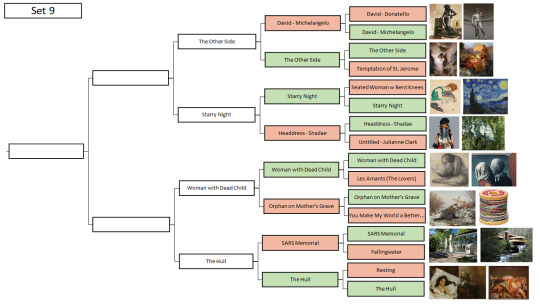
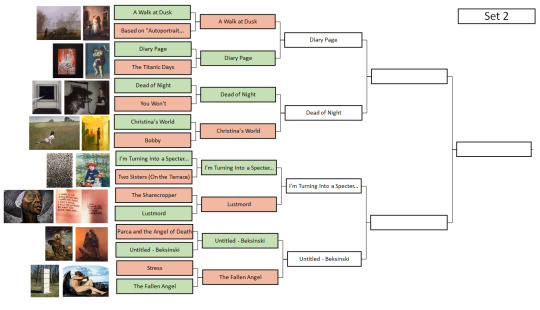
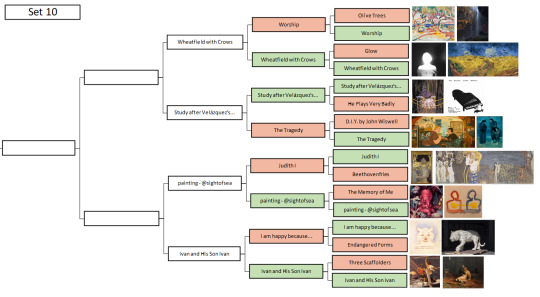
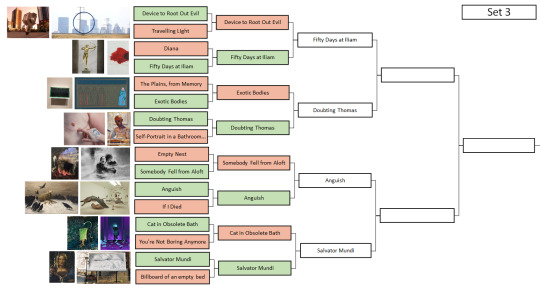

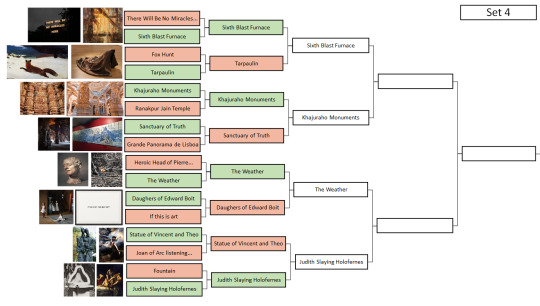
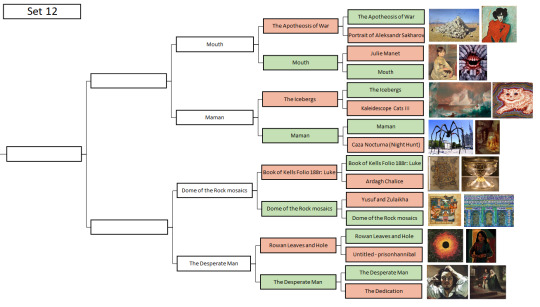
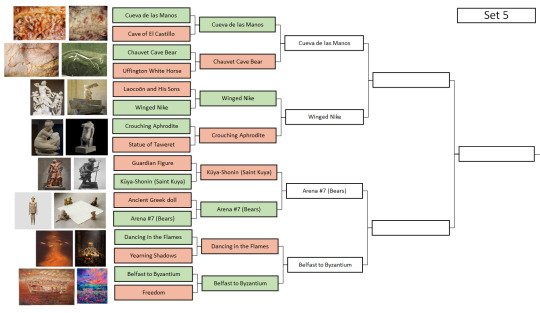
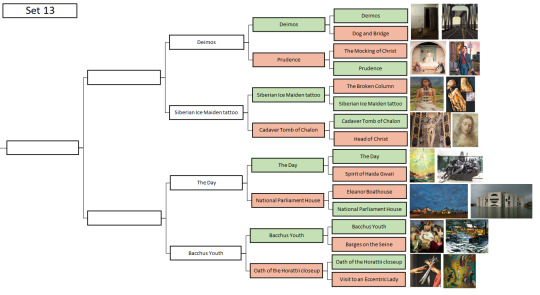
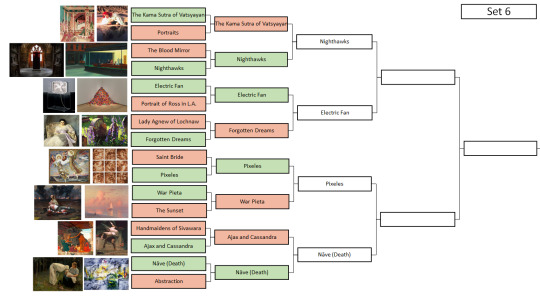
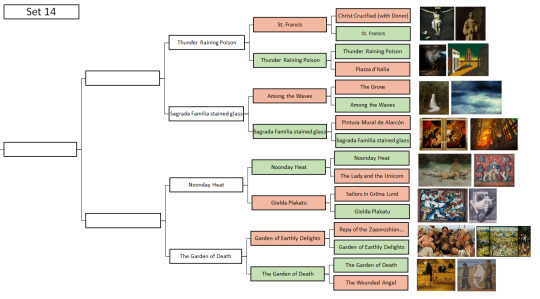


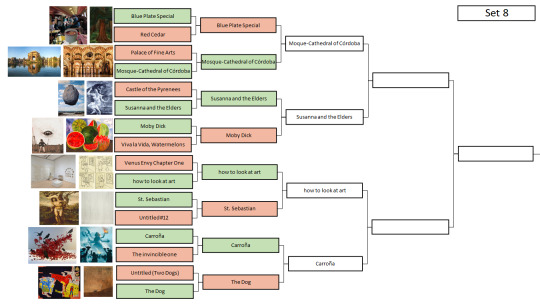

Text form and links under read more
Just a reminder, these are one day polls!
SET 1
MATCH ONE: Lament for Icarus vs Untitled (the angel came to me in a fever hallucination, perched upon my bed as I returned from the bathroom)
MATCH TWO: Figures vs Hubble Deep Field
MATCH THREE: Bath Curtain vs Une Martyre
MATCH FOUR: Can't Help Myself vs Rape
SET 2
MATCH ONE: A Walk at Dusk vs Diary Page
MATCH TWO: Dead of Night vs Christina's World
MATCH THREE: Untitled (I’m Turning Into A Specter Before Your Very Eyes And I’m Going To Haunt You) vs Lustmord
MATCH FOUR: Untitiled (Zdzisław Beksiński) vs The Fallen Angel
SET 3
MATCH ONE: Device to Root Out Evil vs Fifty Days at Iliam: The Fire That Consumes All Before It
MATCH TWO: Exotic Bodies vs Doubting Thomas
MATCH THREE: Somebody Fell From Aloft vs Anguish
MATCH FOUR: Cat in Obsolete Bath vs Salvator Mundi (Saviour of the World)
SET 4
MATCH ONE: Symphony of the Sixth Blast Furnace vs Tarpaulin
MATCH TWO: Khajuraho Group of Monuments vs ปราสาทสัจธรรม (The Sanctuary of Truth)
MATCH THREE: The Weather vs The Daughters of Edward Darley Boit
MATCH FOUR: Statue of Vincent and Theo van Gogh vs Judith Slaying Holofernes
SET 5
MATCH ONE: Cueva de las Manos (Cave of Hands) vs Chauvet Cave Bear
MATCH TWO: Winged Victory of Samothrace vs Crouching Aphrodite
MATCH THREE: Kūya-Shonin vs Arena #7 (Bears)
MATCH FOUR: Enbu (炎舞) (Dancing in the Flames) vs Belfast to Byzantium
SET 6
MATCH ONE: The Kama Sutra of Vatsyayan vs Nighthawks
MATCH TWO: Electric Fan (Feel it Motherfuckers): Only Unclaimed Item from the Stephen Earabino Estate vs Forgotten Dreams
MATCH THREE: Pixeles (a group of 9 works) vs War Pieta
MATCH FOUR: Ajax and Cassandra vs Nāve (Death)
SET 7
MATCH ONE: Meeting on the Turret Stair vs Stańczyk
MATCH TWO: Closeness Lines Over Time vs The Maple Trees at Mama, the Tekona Shrine and Tsugihashi Bridge
MATCH THREE: Survival Series: In a Dream You Saw a Way vs The Kitchen Table Series
MATCH FOUR: In the Grip of Winter vs NAMES Project AIDS Memorial Quilt
SET 8
MATCH ONE: Blue Plate Special vs Mosque-Cathedral of Córdoba
MATCH TWO: Susanna and the Elders, Restored - X-Ray vs Moby Dick
MATCH THREE: how to look at art vs St. Sebastian
MATCH FOUR: Carroña vs The Dog
SET 9
MATCH ONE: David vs The Other Side
MATCH TWO: Starry Night vs Headress - Shadae
MATCH THREE: Woman with Dead Child (Frau mit totem Kind) vs Siroče na majčinom grobu (Orphan on Mother's Grave)
MATCH FOUR: Fighting Against SARS Memorial Architectural Scene (弘揚抗疫精神建築景觀) vs The Hull
SET 10
MATCH ONE: Worship vs Wheatfield with Crows
MATCH TWO: Study after Velázquez's Portrait of Pope Innocent X vs The Tragedy
MATCH THREE: Judith and the Head of Holofernes vs oh god i had a really big epiphany about love and personhood but i’m too drunk for words
MATCH FOUR: I am happy because everyone loves me vs Ivan the Terrible and His Son Ivan
SET 11
MATCH ONE: Water-Lilies, Reflection of a Weeping Willow vs The Grief of the Pasha
MATCH TWO: Passion vs Two Earthlings
MATCH THREE: Seer Bonnets vs Clytemnestra after the Murder
MATCH FOUR: “Untitled” (Perfect Lovers)/The Lovers (TIE) vs Kedai Ubat Jenun
SET 12
MATCH ONE: The Apotheosis of War vs Mouth
MATCH TWO: The Icebergs vs Maman
MATCH THREE: The Book of Kells Folio 188r: Luke carpet page vs Dome of the Rock mosaics
MATCH FOUR: Rowan Leaves and Hole vs Le Désespéré (The Desperate Man)
SET 13
MATCH ONE: Deimos vs Prudence
MATCH TWO: Siberian Ice Maiden shoulder tattoo vs Transi de René de Chalon (Cadaver Tomb of René of Chalon)
MATCH THREE: The Day vs Jatiya Sangsad Bhaban জাতীয় সংসদ ভবন (National Parliament House)
MATCH FOUR: Juventud de Baco (Bacchus Youth) vs Oath of the Horattii closeup
SET 14
MATCH ONE: St. Francis vs Thunder Raining Poison
MATCH TWO: Among the Waves vs Sagrada Família stained-glass windows
MATCH THREE: Noonday Heat vs Gielda Plakatu
MATCH FOUR: The Garden of Earthly Delights vs Kuoleman puutarha (The Garden of Death)
SET 15
MATCH ONE: da oracle vs Panel from Fun Home
MATCH TWO: La Mort de Marat (The Death of Marat) vs Düsseldorf 4 (Museum Kunst Palast)
MATCH THREE: Capriccio vs José y Maria
MATCH FOUR: Lágrimas De Sangre (Tears of Blood) vs Boy Staring at an Apparition
SET 16
MATCH ONE: The Gran Hotel Ciudad de México Art Nouveau interior vs Unfinished Painting
MATCH TWO: Memorial to a Marriage vs A Few Small Nips
MATCH THREE: Saturn Devouring His Son vs Lamentation over the Dead Christ
MATCH FOUR: Little Girl Looking Downstairs at Christmas Party vs Agnus
ROUND 3
SET 1
MATCH ONE: Lament for Icarus vs Hubble Deep Field
MATCH TWO: Bath Curtain vs Can't Help Myself
SET 2
MATCH ONE: Diary Page vs Dead of Night
MATCH TWO: Untitled (I’m Turning Into A Specter Before Your Very Eyes And I’m Going To Haunt You) vs Untitled (Zdzisław Beksiński)
SET 3
MATCH ONE: Fifty Days at Iliam: The Fire That Consumes All Before It vs Doubting Thomas
MATCH TWO: Anguish vs Salvator Mundi (Saviour of the World)
SET 4
MATCH ONE: Symphony of the Sixth Blast Furnace vs Khajuraho Group of Monuments
MATCH TWO: The Weather vs Judith Slaying Holofernes
SET 5
MATCH ONE: Cueva de las Manos (Cave of Hands) vs Winged Victory of Samothrace
MATCH TWO: Arena #7 (Bears) vs Belfast to Byzantium
SET 6
MATCH ONE: Nighthawks vs Electric Fan (Feel it Motherfuckers): Only Unclaimed Item from the Stephen Earabino Estate
MATCH TWO: Pixeles (a group of 9 works) vs Nāve (Death)
SET 7
MATCH ONE: Stańczyk vs Closeness Lines Over Time
MATCH TWO: The Kitchen Table Series vs NAMES Project AIDS Memorial Quilt
SET 8
MATCH ONE: Mosque-Cathedral of Córdoba vs Susanna and the Elders, Restored - X-Ray
MATCH TWO: how to look at art vs Carroña
SET 9
MATCH ONE: The Other Side vs Starry Night
MATCH TWO: Woman with Dead Child (Frau mit totem Kind) vs The Hull
SET 10
MATCH ONE: Wheatfield with Crows vs Study after Velázquez's Portrait of Pope Innocent X
MATCH TWO: oh god i had a really big epiphany about love and personhood but i’m too drunk for words vs Ivan the Terrible and His Son Ivan
SET 11
MATCH ONE: The Grief of the Pasha vs Two Earthlings
MATCH TWO: Clytemnestra after the Murder vs "Untitled" (Perfect Lovers) and The Lovers
SET 12
MATCH ONE: Mouth vs Maman
MATCH TWO: Dome of the Rock mosaics vs Le Désespéré (The Desperate Man)
SET 13
MATCH ONE: Deimos vs Siberian Ice Maiden shoulder tattoo
MATCH TWO: The Day vs Juventud de Baco (Bacchus Youth)
SET 14
MATCH ONE: Thunder Raining Poison vs Sagrada Família stained-glass windows
MATCH TWO: Noonday Heat vs Kuoleman puutarha (The Garden of Death)
SET 15
MATCH ONE: Panel from Fun Home vs Düsseldorf 4 (Museum Kunst Palast)
MATCH TWO: José y Maria vs Lágrimas De Sangre (Tears of Blood)
SET 16
MATCH ONE: Unfinished Painting vs Memorial to a Marriage
MATCH TWO: Saturn Devouring His Son vs Agnus
33 notes
·
View notes
Text
Thinking about how H:SR Kaeya's anger is never directed at the people he holds dear; in case of hurt or upset towards them, he's like a damp match that doesn't catch a spark despite multiple tries. He stays ''damp'' in these cases because the friends he surrounds himself with are reasonable people who understand if what they said/did upset him, and are quick to apologize. He has lived enough to understand most of humanity, in terms of how they act.
Kaeya's true anger, however, is cold, icy; cold as a cadaver, almost impersonal; this fellow isn't your Kaeya.
There's no affectionate glint in pale, frozen diamond; there are no hints of crinkles at the edge of his eye. His gaze is directed at them, unblinking. Emotionless. His hands are still, instead of picking at something to do- at his gloves, at the fur of his jacket. There's usually some semblance of human mannerism when he observes others, but this time he's still as a statue. Almost frighteningly so.
The only thing that moves are icy, diamond-shaped pupils, appointed on the person who has done something so monumental, so monstrous, that Kaeya has discarded his human mannerism.
This Kaeya is much more frightening, and not your friend: his gaze is calculated, detached. He looks at the person who has ellicited his anger and all that is there is a cold assessment of an experiment, with the lights flickering on and off to match his mood. He could cause them serious harm and study how long it takes for them to die, and sleep with it at night just fine.
In a way, this is what happened to Wuchlock in the Liminal Laboratories plotline: when Kaeya offered himself up in Hannah's place, alluding to the fact that he's a Emanator and, as such, could offer many more experiments to bring on himself, the man refused him, citing how they were at an advanced stage with the tests ran on the other being, and that it would have taken them a great deal of time that they didn't had to start again on a newer subject.
For this, Kaeya spent most of the plot psychologically traumatizing the man, sliced off his forearm to use his handprint to access Hannah's room to free her, and coldly informed him that an average human male can die by losing from two and half to four liters of blood before locking him in the sound-proofed room. And, to this day, once a month Kaeya haunts the amnesiac, old man, and will do so until the day he dies, each time taking a bottle of liquor that he doesn't drink from him in a petty gesture.
Kaeya's anger is dangerous, because it's cold and calculated down to the finest details. He knows the human body, knows where to strike, knows how to make somebody suffer. It's a difficult kind of anger to summon out of him, luckily, and only for people who break the morals he imposed on himself in such a way that it's impossible to go back.
Until then, he's your affectionate, kind-of-weird Enigmata fellow.
#from another realm ━ (ooc)#riddle me this; is everything that you remember real and nothing but the pure truth? ━ (H:SR V.)#you no longer know me; shrouded in the fog of mystery ━ (H:SR V. Headcanons)#when the anger so much that you revert back to the LL!kae.ya#chef kiss#gore ment ;;
2 notes
·
View notes
Text
Part 1 of 3! They'll All Know Your Name Y'know
Chittering skulls, splintered bones, chipped femurs, clacking teeth. The necromancers tower stood tall and glorious, a monument to rebirth.
It stood above the land, it stood in waiting, the magistral titan, the culmination of a generations souls. The karmic power of countless slain bodies.
This is where it all lead up to, not to Frisco, but of course they would be instrumental all the same.
I could hear the voices of all those I'd struck down, wailing curses and horridly gavening soulside.
They gave static to my withered hair, my palid skin.
My atrophied muscles tingled with necromantic energy, a swirling mana that permeated the air.
In any case, this body wasn't of much worry to me.
If I fail this attempt, I'll simply wake up back at my parents house, and do it again, all over again.
I couldn't tell you how many times I've done this, the trail of spirits tracing my steps knew no end.
My pardner however, would prove to be of trouble.
Her sensibilities were all too empathetic, the stupid old woman. She was only alive to lead me here.
And then she would leave once she knew the truth.
The same way she did everytime, so so predictable
As if she was some kind of saint by any standard.
All the cultists, all the skeletons, it was a shame to kill my own supporters, but appearances matter.
At last, we'd arrived at the entrance, I greeted the door with a wink, "Abra-Cadaver" I spoke,
This password familiar on my tongue, but one I could never fully remember until I read it.
It's a fun quirk of the world I've noticed, I have all these.. impressions, memories of another time.
Glimpses into other eventualities, glances of odd, familiar sillouhettes, reflections that didn't match.
But not the past, or future; alternate memories from my present, even still, with this knowledge..
I continued to have to "learn" everything again, to discover the key I already had in the lock.
Like I was simply a character in a performance, hung taught to the whims of the curtained gallows.
Forced to act the scenes out in the proper order.
By this time I had already read all of the books, I knew it was necessary to do so before coming.
Same way I knew which horse to get, and who to bring with me, who to help, and who to kill.
Every step in the path printed out before me, even if I didn't always know the reasons why.
It was all a means to an end, steps in the puzzle.
What items to get, what to eat, to drink, what skills to hone I could see it all, I could manipulate it.
I couldn't make her support my goals, you can only do so much with moxie, but I could get close.
I could see clearly what exactly made her clock tick
Every response, every question every answer, the script memorized, ready to preform for all.
The stage set out before me as the infinite horizon.
"How d'ya feel Doc? Being here at last?" I said, with reverence in my voice, she couldn't know where exactly that tone came from, she could only say-
"Time to set aside my Hippocratic oath," cocking her shotgun "let's do some harm" it's what she always says, I nearly giggled at the cheesy line.
We stepped inside, it was just like I remember, a home I'd long since left, returned, it felt so so cold.
The chill in my heart was as calming and soothing as the warmth many describe feeling with others.
But at this point, I couldn't see these, things, as people, they weren't like me, they didn't think,
They simply said and did what the damn "story" demanded, I was so horribly sick of it, but soon, I would achieve my ending, at the top of the spire.
I was practically giddy with delight, a skip to my step as I approached the first of three obstacles.
Impeding our path to the ladder was an entire forts worth of skeletons, the same ones as usual, I'd even taken to memorizing the differences in them.
Despite already knowing the words, I had to read the tablet, the secrets grinned a knowing grimace.
I resisted saying her line for her, I knew the exact moment she would say it, every single time.
"I'm tellin ya you shouldn't be messin with that.."
My reassurance dampened her worries, always did, until the very last one, I couldn't wait for it.
The silly old doctor readied her gun, expecting a fight, I smiled and spoke the words I never forgot.
Turning an entire army of skeletons that once stood just before us into a volley of white shrapnel.
It was so easy, so so easy, as if I'd personally raised all of these skeletons, just to put them down again.
Her sidelong glance at me, boring a hole into my head, oh how anger could become so amusing.
Not even bothering to give her a glance, I knew the glowering expression of discomfort she'd wear.
We made it through the next two floors, reading the runes, annihilating the enemies in our path.
Skipping past it all like nothing, until we reach the top, my goal, my salvation, this was where it would all finally end, once I finally get the right outcome.
I walked towards the necromancer, his hollowed out shell eyed me, it seemed to understand,
Maybe he was once trapped like me, but failed.
Succumbed to the grip of this linearly pathed world, become another set of predictable nothing.
I stood on the platform behest the throne, and awaited her line, right on que "step, back."
Her gun cocked, the sound almost sending me into a laughing fit, it was so comical, it was all so funny.
"Don't worry Alice, it's fine, I can control it" I spoke in a slither, my forked tongue sharp as obsidian, with the color to match, the lies tasted so good.
I couldn't muster the care to listen to this, as she leveled her gun at my center of mass, I did as needed, black fire shining dark in my eyes,
consuming the poor old soul on the pitied throne.
It was impossible but, for a moment I thought I saw the corpse smile, as he dissipated, a lingering expression of satisfaction not unlike my own.
Halting my advance for a beat, why on earth did I recognize.. not purely because I'd seen him before..
A half remembered gust of misplaced nostalgia.
Alice's hands shook in that delightful way, a mix of rage and regret danced like a fire in her eyes.
This familiar comedy bringing me back from my contemplation, I had almost missed my cue.
"Are you gonna pull the trigger?" I said, waiting for her line; "I better not ever see your face again"
And then she would meander offstage, again. The smile on my face threatened to split me in two.
But, as I had this thought, this expectation, I felt something impact me, hitting me, right in the gut.
It was so totally out of the question to me, that for a moment I was entirely unaware what happened.
Something hard, and metal, was burning inside me, I felt my organs scream, my bones crunch.
A ghoulish splatter of gore across the stark white floor, it would be beautiful if I could appreciate it.
I couldn't speak, both out of pain, and the fact I'd never experienced this before, I didn't know the words for this scene, for the first time in hundreds of years I was uncertain, I was truly surprised.
End of Part 1! Split In Two Because It's Too Long
#original character#original writing#shadows over loathing#west of loathing#sol#wol#writing#oc character#writers on tumblr#creative writing#writer#original characters#western
9 notes
·
View notes
Text
Necropolis now

It was a tomb with a view, but Gilrast didn't like to use it. It was heart-breaking, to look out across his erstwhile kingdom: the desert beyond was free to shift and dance, its people scuttling like beetles over distant dunes, but he was trapped within his grave. An exile from the land of the living, and a prisoner behind these greenstone walls. It didn't help to remind himself of that.
Far better to make himself at home. His tomb had been bestowed with enough rooms to occupy an army, and it was certainly enough to keep one man occupied, sorting the possessions they'd seen fit to bury him with. They had fashioned him a mighty mausoleum, a sepulchre fit for a king, and it was as much palace as final resting place.
Its construction had begun from the moment Gilrast had been crowned, the second that his fingers touched the sceptre of command, and it was complete before he'd grown used to that heft in his hand - let alone the weight of the realm on his shoulders. He might have been born to rule, but that hadn't meant that it came naturally. He'd been born to die as well, and he wasn't proving very good at that either.
In the distance, through the high slit windows he avoided like the Hopping Plague, the desert was littered with such monuments to history. Each ruler of the past had been treated to the same privilege, and the crypts had crept larger year on year, their architects growing more expansive and expensive in their plans. They had also become more proactive, after the early death of poor Queen Yelfen had left her corpse with nowhere to lie - it had been awkward, having to disturb her parents' rest to lay her at their feet. Better to get an early start, they thought.
King Gilrast's tomb was ready well before his time. It was an icosahedron of chiselled greenstone, interlocking sculptures forming solid walls: every brick a work of art, every perfect piece in place, every facet beautiful. It rose above the desert dunes, but also sank its roots into the darker sands that lay beneath - there were cooler chambers, an airtight crypt in which his body could lie, preserved for years before it finally succumbed to the decay of time.
In the end, he'd lasted longer than even they could dream. That shaded vault had been designed to slow decomposition as far as possible, but as a living cadaver he'd defied it entirely, beyond the graceful ageing of a man now freed of all of life's demands. Heavy had been the hand which held the sceptre, but now both palms were bare. Gilrast's days were his to spend as he chose, provided that he chose to spend them wondering alone, and he was beginning to appreciate his own company.
It had required some adjustment. The royal throne, and the living palace which surrounded it, had taken long enough to get used to, but it was nothing to this castle of ghosts. Gilrast was surrounded by reminders of his missing tombmates: a silence that echoed in the absence of voices, sunlight that fell where their shadows should dance. He passed through living quarters for supposed servants, barracks for his eternal guards - and of course the rooms for his widow to be buried alongside him, as tradition dictated.
Tradition had failed to dictate what should happen if she were to pass away first.
The only precedent had been to marry again - to marry young, and whole, and healthy. That was what King Halsin had done, his second wife surviving him with ease. But Gilrast was not his great-great-great-grandfather. He had married once, for love, and ruled for many years with the late, beloved Queen Elfira by his side. When the Hopping Plague had taken her, tending to those most in need, he had wept over her casket, refusing to let them remove him from hers.
Her body had been due to be delivered to the vault; there to lie in wait for his arrival, however many years later. Gilrast almost wished that he had been the first to die, but realised the selfishness of that regret, and the cruelty of the whole tradition: in that case, Elfira would have been consigned to be entombed by his side, as would the servants and the guards, left as an entourage for his passage to the afterlife. They would have been together, but she would have been alone; divorced from the rest of her life.
The mourning King Gilrast had been spared the same fate. As monarch, he had been allowed to continue to rule, placing his wife in cold storage until such a time as he joined her in death. He had been expected to move on, to live - and perhaps find a new queen to take up those posthumous responsibilities, to grieve a lifetime by his grave. But, unable to love again, he'd chosen to be buried with her.
Not dead, of course. The dead made for poor mourners. The black veils fit them ill, shrouds which clung to clammy skin, their tears leaking from all the wrong places. With his last command as king, Gilrast insisted he be buried alive; all the better to grieve for her, to honour her, and to ensure she wasn't left inside this empty charnel house alone.
The kingdom suffered in his absence. Through windows that he didn't use, those distant beetles scurried more and more: fallow years and fearful decades shifted with the dunes, through drought and famine and plague again. Wars were fought and won and lost, and many others died, their graves unmarked whilst Gilrest laboured in the bowels of the world's greatest headstone - working to install Elfira's name in place of his own.
"Your Grace? Please, I beg you, answer if you are there."
Gilrest didn't like to look out upon the world. He had come here to pay his respects to the dead, to look inward, and had turned his back upon the lands of the living. Let the kingdom fall to someone else, he'd thought. He might have been their ruler, but there was only one subject that interested him now, and he wished he had paid as much attention to her then. He had already lost his home, and he would join her in their new one.
"Please, be alive. We are desperate."
But there came a day that the world came to look in on him. The group were refugees from the latest war, an army of the displaced, having backed the wrong cause somewhere along the line. They had also been deprived of home, and hope, but heard a rumour that the Last Good King still lived, and would return in a time of his kingdom's greatest need. The King Under The Mountain. The Widower King. They opened up the tomb, and called to him for their salvation.
"Your Grace?"
He was not where he'd been left. They made their way into the burial chamber, lighting torches which flickered in the dark, the shadows which had been his veil, but found his casket empty. Instead, he appeared in the corridor behind them: not a ghost, though his skin had taken on a less-than-healthy pall, and once flowing black locks were now thinning and grey with his robes.
"I'm not sure that I am, now." His voice was weak from lack of use. He'd spoken aloud to Elfira, at the start, but the echo had done too much to remind him of their solitude, or of her silence in response. Better to talk to her inside his mind. "Has the kingdom not replaced me?"
"Too much, and yet not enough," one of the visitors replied. "We have four kings and two queens, your grace - and yet no government between them."
"Our crops rot in their fields," another added. "Our people take no interest in the future, too consumed with this struggle for the present, driven to fight for one faction or the next.
"Our cause failed," the third told him. "The others turned us out of our homes, another slither of land they might contest between themselves. We need you to come back, your grace. We need real leadership again."
Gilrest considered all that they had said. He was no leader, he knew, whatever colours their nostalgia might have painted him. The kingdom had been stable under his command, but it had been as stable when he'd found it. He'd done nothing but allow the system to maintain itself, and managed not to overturn the applecart - until he had, when he left. Whatever had happened since, the fault might well be his.
"The kingdom does not need me," he told them. "Once, perhaps, but no more. My strength has failed. It failed the day my queen was taken, and I knew that from then on I could no longer be your king. I am sorry to disappoint you, truly, but I fear that as a saviour I would only disappoint you more."
"But... you are our last hope. We have travelled here from nothing, and we have nowhere to return without you by our side."
"Then stay by my side," Gilrest said, looking to the place where Elfira lay, the side that he'd attended all these years. He gestured around them. The architects had sculpted these walls, but Gilrest had decorated them, plastering these catacombs with signs of his enduring life. "This tomb is a city all my own, and it grows lonely. You are welcome to stay, for as long as you like."
The refugees looked to each other in disbelief, the relief clear on each of their faces. "A new city, in the image of the old?"
"So you would be our king again, after all - just not in the way we had planned."
"No." Gilrest nodded to Elfira's casket. "This city has a queen. Here I am a subject, not a king - but I grow old, and frail, and no longer fit for service there as well. It would be good to have some new blood, I should think. These tombs were built for dozens of attendants, mourners to see the dead pass safely on, to keep their memory alive. I cannot lead you, but perhaps you might still follow in my wake. Please, if you stay... will you remember her for me?"
7 notes
·
View notes
Text
The Brief: Painting | Research on Oil Painting and Preferred Painting Style
Oil Painting: Techniques and Significance
Oil painting has been one of the most enduring and versatile mediums in art history, particularly during the Renaissance. The use of oil paints became popular in the 15th century due to their rich color depth, slow drying time, and ability to create smooth transitions between tones. This made it an ideal medium for achieving lifelike details, atmospheric depth, and dramatic lighting effects.

The Lamentation over the Dead Christ (1495) - Sandro Botticelli
Key oil painting techniques that will be relevant for my work on The Sins include:
Chiaroscuro: The use of strong contrasts between light and dark to create a sense of three-dimensionality. This technique, heavily used by Caravaggio and later influenced by Michelangelo’s sculptural approach to form, helps in emphasizing drama and movement.
Impasto: The thick application of paint to create texture and a more sculptural quality on the canvas.
Glazing: Layering thin, transparent coats of oil paint to build depth and luminosity.
Sfumato: A soft, almost smoky blending of colors without harsh outlines, famously used by Leonardo da Vinci to create atmospheric effects.

Chiaroscuro in Art - Saint Jerome Writing (1607) - Michelangelo Merisi da Caravaggio
Renaissance Art Styles: Inspiration from Michelangelo
Michelangelo’s approach to painting was deeply sculptural, treating the human form with an almost monumental presence. His figures are defined by dynamic poses, exaggerated musculature, and intense emotion, all of which I want to incorporate into my depiction of the sins.


LEFT: Michelangelo di Lodovico Buonarroti Simoni (1475 - 1564) | RIGHT: The Pietà
Key elements of Michelangelo’s style:
Anatomical precision: His deep understanding of human anatomy, gained from studying cadavers, allowed him to create highly realistic and powerful figures.
Dramatic composition: His paintings, much like his sculptures, convey movement and energy through the twisting, contorted poses of his subjects.
Grand scale and theatricality: Works like The Last Judgment in the Sistine Chapel emphasize a chaotic, almost overwhelming arrangement of figures, something that could work well when portraying the overwhelming presence of sin.
Fresco influence: While my painting will be done digitally in 3D, Michelangelo’s fresco technique—where forms seem to push out of the surface—will inspire the way I sculpt the composition in 3D.
Sources:
7 Oil Painting Techniques that Every Artist Should Know | artsupplies.co.uk
OIL PAINTING GUIDE FOR BEGINNERS - Tips, materials and techniques | annabregmanportraits.co.uk
Michelangelo, his Sculptures and Life | michelangelo.org
Michelangelo: Mind of the Master | getty.edu
0 notes
Text
Corpse in the Closet
John Brown's body may have been moldering in the grave, as the old song goes, but the body of his son, Watson, ended up being stored in an Indiana closet! The story of the cadaver of Watson Brown is one of the weirdest ever told about the pre-Civil War era.
John Brown was an abolitionist with a hatred for Slavery so strong that he would do anything to stop it: even kill. Many northern abolitionists viewed him as a hero (if not also a fanatic), but he was seen as a madman and a zealot in the South and feared by everyone who knew him. In 1856, he had been one of the fighters against slavery in "Blood Kansas," and three years later he devised a plan that he believed would create an army of slaves that would battle to end slavery once and for all. On October 16, 1859, he put his plan into action.
He and fifteen recruits (including his four sons) armed themselves heavily and set out for Harpers Ferry, Virginia, under cover of darkness. They managed to surprise the handful of defenders at the small federal arsenal there and easily took it over. They planned to use the weapons they captured for Brown's slave army, but it all backfired when the first townsperson killed in the raid was a free black man. Instead of being met by masses of escape slaves eager to join the cause, Brown was met by angry townspeople. These were soon joined by a militia force, and when Brown refused to surrender, they stormed the building and overpowered his men. Brown was wounded, captured, and turned over to Virginia authorities. Ten of his followers died at Harpers Ferry, including his sons Oliver and Watson.
Brown was tried for treason against the state and conspiracy to incite insurrection, found guilty, and sentenced was executed, and both his body and the body of his sons Oliver were buried. However, for many years, no one knows what happened to the body of his other slain son, Watson. It would turn out that instead of being buried, his body had been preserved in a salt barrel and sent to a medical school at Winchester, Virginia. It remained there in storage for the next three years.
Meanwhile, the Civil War had begun in earnest. When Dr. Jarvis Johnson of the Twenty-seventh Regiment of Indiana Volunteers arrived at Winchester with occupation troops in 1862, he took command of the medical college. He soon learned that he possessed the body of Watson Brown and that southerners wanted it. Johnson refused to turn over the body because he believed it was symbol of the fight against slavery.
What happened next was described by Johnson in 1882, "I, afterward, in the summer of 1862, shipped the body by express to Franklin, Indiana, that point being the nearest express office to my home, then Morgantown, Indiana, and the said specimen had been in my possession and under my control ever since. And I have no doubt whatsoever but that it is the son of the heroic John Brown."
Johnson kept the body, which was eventually reduced to a skeleton, as a treasured possession. When he and his family moved to Martinsville, they kept the remains in a second-floor-closet on a sun porch.
In 1882, Dr. Johnson learned that a monument was being placed in honor of John Brown and his sons at the old Brown family farm. In a newspaper story, he read that Mrs. Brown knew nothing of what had happened to the body of one of her sons, so he quickly wrote to her and told her Watson's corpse was in his possession.
John Brown Jr. traveled to Martinsville and, with Dr. Johnson and the stage geologist, John Collett, authenticated the identity of the skeleton. We can only hope that Johnson removed the remains from his closet before the brother of the dead man arrived.
The younger Brown took the body to North Elba, New York, and it was placed in the family burial ground, bringing to an end one of the longer, weirder journeys ever taken by a corpse.
0 notes
Text
Novella November - Day 28
@novella-november
Oh my god, I got so much done today!!! And with only a couple of days left!
So, to start with...
WORDCOUNT: 64,785
Holy Fuck! I've passed the NaNo goal (though not supporting that group), and my own personal goal! (60K) And also another thing too. I mentioned in a previous post-
My story is certainly taking shape. I'm approaching some of the major plot points, twists in the middle and such. There's one twist which is my true goal. If I can get there before the month is over, then I'll be thrilled!
And I reached that one today! it would be a bit of a spoiler to discuss, but I'm genuinely tempted to do so anyway. I am super excited to have reached this plot twist, and will likely be getting right back to it after finishing this post.
God, this story is coming together. I am overjoyed. I've likely still got a fair way to go before the end of the novel, but I am thrilled I've got this much done in a month. And the editing will be monumental too, but so what? If I keep going I might get this novel finished before the end of the year.
I always feel a little bad, bragging like this, but I am genuinely proud of everyone participating. I've seen from the graph on TrackBear that most of you have crossed the 30K line, which is spectacular. And those that haven't, at least you've written something. A lot of something. You've still written more than some non-writers ever will.
And now, we enter the closing days.
...I wonder if I can hit 70K before closing?
Anyway, my usual snippet is below. And do you know what? I mentioned I was tempted to talk about that plot twist, so here it is! I'm not gonna add any context though.
Enjoy, and good luck in the final days!
“Angela?” Simon reached out to her warily. She recoiled from his touch. Her mind was screaming at her as the next entry played.
“Entry Seventeen: While the sovereign remains have been plumbed to their depths, I fear we have learned all we can without external help. Viable cells have been located during the biopsies, and so far some of the experiments are stable. The growth medium, Compound 15, is proving suitable, but growth is very slow going. There may be elements to the Sovereign biology we can’t quite control yet. But I have reached out. All the same, one of the most recent projects has begun to grow quite promisingly. Subject 34, already showing some basic formation of beginnings. Still, it will be months before that one is at the stage of some of the others. And unless we can locate another sovereign cadaver, then we are on our own from here.”
The door finally opened, Pheobe leaving the circuit panel hanging. It swung wide, the room inside vast and dark. They struggled to find a light switch.
“Entry Thirty: Progress, finally. The research we’ve recently achieved has been, rather suitably, a godsend. The growth medium has been adjusted and the amniotic fluid adjusted. Already we have some fascinating results. Growth, not dissimilar to a human embryo. Still, some of the strongest specimens are struggling. A missing component perhaps? Even so, we are beginning experiments with accelerated growth. We do not have eighteen years to wait for an adult specimen. Soon, we will have a living sovereign before us.”
The light came on with a flash. The room was filled with large cylindrical tanks, each taller and wider than a man. Most were empty, but a few had lingering green fluid in them. And then there was one, wired up to nexus of cables, a monitor attached that wasn’t on the others.
“Entry Fifty One: *Sigh* While the accelerated growth is finally reaching fruition, we are experiencing a new problem. One of the subjects had seemingly grown strong enough to extract from their tank today, but there was nothing. Nothing behind the eyes. We are missing something vital. I will reach out again. Maybe I’ll actually get an answer this time.
The chamber with the cables had clearly been the focus, computer banks and systems set up to monitor it. It was empty now, the glass having been slid cleanly open. Angela approached it, a hand extended, her heart pounding in her chest and eyes ready to overflow.
Entry Sixty Five: Success! We have achieved the impossible! A living, breathing sovereign! Subject 34, still strong after all this time. With the addition of the psychic element, the mind has sprang to life. She is still incomplete, like a child, learning simple concepts for the first time, but we have produced a full adult sovereign. And she is magnificent. It is strange though, to have reduced a thing of divinity to a science. But she will not be the last. Golada will change. The world will change. Subject 34 will change the world.”
“Angela?” Simon checked.
She was leant against the tank, her head feeling like it would burst. Her hand right over the number 34, stencilled on the side. This was… This was… The thought wouldn’t complete! She could feel the answer but… She knew this wretched place!
“Oh my god…” Jess’s voice gasped over the Tannoy. “Oh god! Angela… I’m so sorry,” her voice cracked.
Feet padded and Jess came running, a computer tablet in her hand. She showed what she’d found to Simon. She swallowed before she could speak. “Subject 34…” she explained.
Simon took the tablet, and found a picture showing the subject.
A picture of Angela looked back at him.
#writeblr#writing#writers on tumblr#writing community#novella november#lamura dex writes!#NinthRealmStory
1 note
·
View note
Text
When time takes its final toll
Throw me in the common hole
Where beggars, orphans and destitute are found
Set my body to the rotting mound
Our cadavers do the decomposition dance
To give the worms their food and thier chance
To put right my debt to earth
My ethereal form rises up in mirth
Above rows of marble teeth
Capturing remembrance of life and grief
Bound to clay that no longer matters
On the fringes of urban splatters
How infrequent and impertinent it is after all
Where we are all to eventually take the fall
And what could show defiance the most
To build monuments to our decaying hosts
0 notes
Text
The Magnificent Seven – Part One Highgate
Author: Molly Malone
Highgate Cemetery is a monument to the neo-Gothic vapourings and dramatics of Victorian Londoners. Designed as a ‘garden’ cemetery, it was built in the early part of the nineteenth century in an effort to prevent the over-population of the City of London by the dead. Nowadays it is a tourist destination as well as a functioning cemetery, and a celebration of managed decay and Victorian symbolism.
In 2024, if you wander around the City of London, you will inevitably come across countless tiny, well-kept and verdant gardens squeezed between offices, many of which are lined with gravestones that have been placed haphazardly against walls or, memorably, stacked around a tree in Old Saint Pancras. You don’t need to look too carefully: there are graves everywhere. Bunhill Fields off of Old Street is a wonderful larger example. Some are dotted with tombs worn smooth by centuries of exposure. These were the burial grounds of the Square Mile, which became an affront to both the sensibilities and the nostrils of Londoners. These supposed resting places were managed by unscrupulous clerics, who profited from each interment and piled bodies in pits twenty feet deep, before covering them with a mere dusting of earth. Bones, and worse, littered the ground. Grave robbing was a lucrative business, frowned upon by polite society but quietly encouraged by hospitals desperate for cadavers to train surgeons on.
The outcry against both this treatment of the dead, and the ‘miasma’ of decay that emanated from these burial grounds (which was considered toxic enough to be deadly) was a topic of heated discussion among those who were forced to bury their dead there, the newspapers and, eventually, the Houses of Parliament. Although it took several more decades for legislation to pass that would adequately address the sheer number of dead bodies resulting from the increasing population of London, work on the building of London’s Magnificent Seven cemeteries began in 1833.
Arguably the most famous of the Seven is Highgate, which opened in 1839 and is home to more than a few famous architectural wonders and notable inhabitants. In its heyday, Highgate was manned by enough security to warrant the cost of both burying a loved one there and the not terribly convenient necessity to travel to Highgate. The idea of garden cemeteries had been developed on the Continent, and Victorians were encouraged to stroll through a secure, beautifully maintained, and carefully curated space. Highgate could be seen from the centre of the City, and it was so different then to its current state of overgrown wildness. Sunday picnics were commonplace, although they are emphatically discouraged these days. Dozens of gardeners were employed, and the cemetery was run as a profitable business.
Walking around Highgate, you are struck by the symbolism associated with death. A grave was a Victorian Insta account, and clues adorn many of the monuments as to the achievements, and hubris, of those buried beneath. There are plenty that are common in all British and Christian cemeteries; a broken column indicating a young life cut short; a draped urn representing the veil between the living and the dead; three stones supporting a cross which are symbolic of the father, the son and holy ghost. The cross itself had been out of fashion for a few centuries but made a big comeback thanks to the Victorians. The grave of a world-famous champion bare-knuckle fighter features a carved dog, his faithful companion who was his chief mourner. Tom Sayers was a world-famous fighter and a working-class hero, and his funeral procession stretched from Highgate to Tottenham Court Road.
The tomb of George Wombwell is topped by a sleeping lion. In life, George was a celebrated zoo keeper, with his own private collection of exotic animals including, you’ve guessed it, a very tame lion called Nero.
The list of those laid to rest at Highgate is fascinating. Nearly two centuries of the notable, the rich and the inspirational are amongst the 170,000 who can be found there. George Michael, Bob Hoskins, Michael Faraday, Joseph Lister and Karl Marx are just a few. There is one relatively recent grave that particularly catches the eye, however, as you follow the main path into the West Side of the cemetery. That of Alexander Litvinenko, the Russian defector who was poisoned by Putin’s regime in 2006. The grave is strikingly modern. It features a photo of Litvinenko, itself an exceptionally unusual feature at Highgate. Most of the West Side of the cemetery is being slowly worn away by the weather and swallowed by mature trees and spring flowers. The graves are shades of grey and often barely legible. Litvinenko’s grave is pinkish-red and was, by necessity, dug deeper than most. His lead coffin is buried twelve feet below visitors’ feet as a precaution, after his murder through the use of polonium-210. This radioactive substance admittedly has a half-life of less than five months, so is unlikely to cause any further mischief.
Highgate is also home to a particularly rare type of cave spider, which is monitored by London Zoo and can be found in the overgrown tunnel enveloped by trees that is the Grade I listed Egyptian Avenue. The locked crypts lining each side of the Avenue are not full, and if you can prove lineage to those already interred there you are guaranteed a spot. However, the eye-watering cost of spending your afterlife in Highgate might be a consideration. It is currently estimated that a pretty basic full-body plot costs between £25,000 - £30,000. A place in an Egyptian Avenue tomb in 1839 cost the modern-day equivalent of up to £150,000.
Beyond the Avenue is the beautiful Circle of Lebanon, lined with tombs, including that of the activist and writer, Radclyffe Hall. Atop the Circle stood a famed cedar tree, from which the Circle took its name. The 200-year old tree was recently lost to a fungus and in its place now grows a baby cedar, but the loss of the original tree is felt keenly by those working and volunteering at Highgate.
The Terrace Catacombs, which visitors are only able to enter whilst on the official tour of the West cemetery, speaks eerily and eloquently of the turbulent history of Highgate, and the general stupidity of people. Originally, each entrance to the Catacombs had been guarded, which reassured both the families of the dead and the particularly practical. Doctors, being more aware than most in the nineteenth century of the prevalence of grave robbing, were keen to be safely ensconced in the locked and guarded Catacombs after meeting their maker. Coffins were lead-lined and placed on shelving. This practice left them exposed and vulnerable in the late 1960s. A sensationalist newspaper report of a ‘vampire’ roaming Highgate Cemetery led to the vandalism and destruction of much of the cemetery, including the desecration of the bodies laid to rest in the Catacombs. I will cover this more extensively in another blog, as it makes for very interesting reading. The damage took years to repair, coming as it did after several decades of cemetery-wide neglect after the Second World War. In fact, it was only addressed when The Friends of Highgate group was formed in 1975 to repair and protect the site.
For those of us who find beauty, comfort, and peace in a walk around a cemetery, there are few like Highgate. My interest in these places stems from my local cemetery in Chingford, London. Not considered one of the greats, it is notable perhaps only for its two most famous residents, the Kray twins. I clearly remember their funeral processions, one of which I watched from my junior school window, attended by an interesting if, by then, anonymous cohort of 60s gangsters, molls and actors, glamour faded after thirty years. Chingford Cemetery also features a pauper’s grave, a mound of earth with a few markers sticking out haphazardly. There are Commonwealth war graves and an overgrown area completely obscured by feral ivy and holly trees, where the stone markers are almost as buried as those they are intended to commemorate and completely illegible.
Cemeteries are havens for wildlife. From the ubiquitous grey squirrels of Chingford to the striking green parakeets that have spread from central London to inhabit most trees within the M25 over the last couple of decades, many of which have made Highgate their home. Perhaps it is simply the knowledge that cemeteries of this type are dying out if you’ll forgive the pun. As cremation becomes a more popular and cost-effective option, the marble tombs of our recent ancestors are icons of a lost age. Life and death are no longer celebrated in stone.
1 note
·
View note
Link
0 notes
Text
I grappled with deciding whether to make a post on this during October, because it can get rather graphic and may be disturbing to some. So anyways, wanna hear about cadaver monuments?!
So, during the late Middle Ages, Memento Mori was very popular (as discussed prior) and as such, the funerary monuments of church members reflected that. The specific type of cadaver monument that I was introduced to is transi (art depicting decomposing bodies rather than just a skeleton) however, cadaver monuments can also be skeletons or a shrouded body. I find it really fascinating how they were able to sculpt realistic decomposing bodies in stone. It’s one of those things that most people would find disturbing that I find fascinating!
Anyways, go check it out if you’re interested.
1 note
·
View note